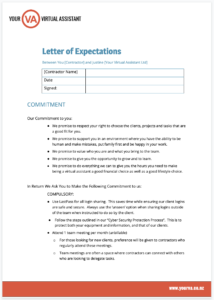Trust is earned and as you build a relationship with your virtual assistant it can take time to feel comfortable delegating parts of your business, and sharing confidential information.
If you’ve hired someone who shares your core values, someone you feel comfortable with, you’re already well on the way to a healthy relationship. And a healthy relationship where you can be open and honest with each other will stand the test of time.

It’s a given that you need to define your expectations for your virtual assistant before you officially hire them, but don’t underestimate the value of continually outlining these going forward. Not only should you communicate your own expectations, but your VA should do the same with you. You need to clarify what you want to outsource, how you expect them to perform and what outcomes you expect them to achieve. Don’t forget to explain the nature and purposes of their assigned tasks so they understand why and how to complete them.
In return your VA should express their expectations of any resources they expect from you, the level of flexibility and communication they require.
 We outline our own expectations as part of our contractor onboarding, and learn those of our clients throughout their own onboarding process. No two clients have the same expectations and it definitely saves a lot of frustration in the future to clarify them from the start of your relationship.
We outline our own expectations as part of our contractor onboarding, and learn those of our clients throughout their own onboarding process. No two clients have the same expectations and it definitely saves a lot of frustration in the future to clarify them from the start of your relationship.

Trust is helped by a sense of connection and it’s the role of every leader to foster these connections and create a culture where your team feels part of something. This is relevant whether you have a team of two or a team of 22.
This article, 10 ways to connect with people in your workplace, has some actionable tips. Good tips!
One way we foster connections is to ask for a personal and professional win in our team catchups. We also have a monthly team meeting that, because we’re a virtual team, focuses on personal connections. We ask a question each month along the lines of:
-
What’s something you’ve always wanted to do but haven’t done yet? Why not?
-
What’s the best gift you’ve both given, and received.
-
If you had an extra hour each day, how would you spend it?
-
What has been the best day of your life so far?
-
What’s the worst job you’ve ever held?
-
When you were young, what did you want to be/career dream for when you grew up?
-
What do you do to cope with stress?
- If you could choose a super power, what would it be?
These questions have given us incredible insights into what makes each of us tick, while creating connections that wouldn’t have happened if we didn’t take the time to get to know each other.

Communication Expectations
Establish channels of communication that work efficiently for both you and your VA. Determine what kind of task, problem or question would require which method of communication.
For example you may prefer to communicate via email, having established that for anything urgent text is the best way to get a prompt reply.
Assigning priorities with a distinct form of communication means you don’t won’t waste time in the future with a lengthy email trail when a call would suffice.
Tools we use to communicate with include:
- Phone
- Slack
- Microsoft Teams
- Text
- Audio Files
- Zoom
- Google Meet
- Loom Screenshots
- Email!
- Skype
- Private Message
- Project Management Tools
- Social Media Chat
It’s also important to set boundaries by limiting communication availability to standard working hours, and agree that when either one of you has blocked off hours that these will be respected. However, you don’t want to go radio silent without giving your VA notice that you’ll be offline for an extended period. By establishing a routine and standard protocol for questions and emergencies, you’ll have a clear understanding of how to interact.
Open Communication
Open and honest communication can involve having difficult conversations. One tool we use is EOS’s Same Page Meetings (see video below). Whether it’s positive or constructive, open communication is critical to both building trust and making sure you and your VA are on the same page.
Of all the tips mentioned in this article, communication is the most important area when it comes to building trust. If we have problems with our own clients, it’s nearly always because communication isn’t working properly.

Finally, be flexible. If nothing else, the last three years have taught us the importance of having an open, agile mindset.
When you’re flexible and open-minded, your virtual assistant will feel more confident coming to you with ideas and suggestions.
Trust is a two-way street. It’s easier to be flexible when you’ve built trust, but it’s hard to trust someone who isn’t flexible.
![Outsourcing Made Easy [free guide]](https://yourva.co.nz/wp-content/uploads/2023/07/Book-Cover-Template-2.png)
DOWNLOAD YOUR FREE GUIDE
A step by step guide on how to navigate your first month with your new VA.
So you can start on the right foot and get the very best from your investment in your new team.




